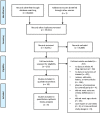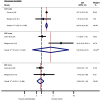Drugs with anticholinergic effects and cognitive impairment, falls and all-cause mortality in older adults: A systematic review and meta-analysis
- PMID: 25735839
- PMCID: PMC4541969
- DOI: 10.1111/bcp.12617
Drugs with anticholinergic effects and cognitive impairment, falls and all-cause mortality in older adults: A systematic review and meta-analysis
Erratum in
- Br J Clin Pharmacol. 2015 Oct;80(4):921-6
Abstract
Aim: The aim was to investigate associations between drugs with anticholinergic effects (DACEs) and cognitive impairment, falls and all-cause mortality in older adults.
Methods: A literature search using CINAHL, Cochrane Library, Embase and PubMed databases was conducted for randomized controlled trials, prospective and retrospective cohort and case-control studies examining the use of DACEs in subjects ≥65 years with outcomes on falls, cognitive impairment and all-cause mortality. Retrieved articles were published on or before June 2013. Anticholinergic exposure was investigated using drug class, DACE scoring systems (anticholinergic cognitive burden scale, ACB; anticholinergic drug scale, ADS; anticholinergic risk scale, ARS; anticholinergic component of the drug burden index, DBIAC ) or assessment of individual DACEs. Meta-analyses were performed to pool the results from individual studies.
Results: Eighteen studies fulfilled the inclusion criteria (total 124 286 participants). Exposure to DACEs as a class was associated with increased odds of cognitive impairment (OR 1.45, 95% CI 1.16, 1.73). Olanzapine and trazodone were associated with increased odds and risk of falls (OR 2.16, 95% CI 1.05, 4.44; RR 1.79, 95% CI 1.60, 1.97, respectively), but amitriptyline, paroxetine and risperidone were not (RR 1.73, 95% CI 0.81, 2.65; RR 1.80, 95% CI 0.81, 2.79; RR 1.39, 95% CI 0.59, 3.26, respectively). A unit increase in the ACB scale was associated with a doubling in odds of all-cause mortality (OR 2.06, 95% CI 1.82, 2.33) but there were no associations with the DBIAC (OR 0.88, 95% CI 0.55, 1.42) or the ARS (OR 3.56, 95% CI 0.29, 43.27).
Conclusions: Certain individual DACEs or increased overall DACE exposure may increase the risks of cognitive impairment, falls and all-cause mortality in older adults.
Keywords: all-cause mortality; cognitive impairment; drugs with anticholinergic effects; falls; older adults; risk scoring systems.
© 2015 The British Pharmacological Society.
Figures




References
-
- Bostock CV, Soiza RL, Mangoni AA. Association between prescribing of antimuscarinic drugs and antimuscarinic adverse effects in older people. Expert Rev Clin Pharmacol. 2010;3:441–52. - PubMed
-
- Brown JH, Laiken N. Goodman and Gilman’s the Pharmacological Basis of Therapeutics. 12th edn. NY, USA: McGraw Hill; 2011. Muscarinic receptor agonists and antagonists; pp. 219–37.
-
- Rang HP, Dale MM, Ritter JM, Flower RJ, Henderson G. Rang and Dale’s Pharmacology. 7th edn. Edinburgh, UK: Churchill Livingstone; 2012. Cholinergic transmission; pp. 151–73.
-
- Picciotto M, Alrega M, Jentsch D. Neuropsychopharmacology: The Fifth Generation of Progress, eds Davis KL, Charney D, Coyle JT, Nemeroff C. Philadelphia, USA: Lippincott Williams and Wilkins; 2002. Acetylcholine; pp. 1–14.
Publication types
MeSH terms
Substances
LinkOut - more resources
Full Text Sources
Other Literature Sources
Medical

